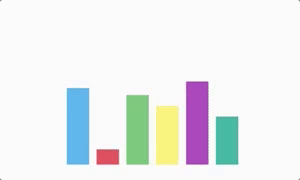您好,登录后才能下订单哦!
我们假设一种情况,如果应用程序使用条形图显示给定年份的产品类别的销售额,用户可以选择另一年,然后该应用程序将动画到该年的条形图。如果产品类别在两年内是相同的,或者恰好是相同的,除了在其中一个图表中右侧显示的其他类别,我们可以使用我们现有的代码。但如果公司在2016年有A,B,C和X类产品,但是在2017年中断了B并推出了D?

动画效果可以做得非常好看,但仍然会让用户感到困惑。为什么?因为它不保留语义。它将表示产品类别B的图形元素转换为代表类别C的一个图形元素,而将C的图形元素转换到其他地方。正因为2016 B恰好是在2017 C后来出现的同一位置,并不意味着前者应该变成后者。相反,2016年B应该消失,2016年C应该向左移动到2017年,而2017年D应该出现在右边。我们可以使用传统的合并排序列表实现这种混合。
我们可以分别给每一个条形以不同的颜色,然后使用颜色来区分销售的产品,一种颜色代表一个产品,当一种颜色消失时,说明该产品已经下架,反之,则说明新产品已经上架。
通过语义对应的组件进行复合值之间的线性插值(lerp),当组件形成排序列表时,合并算法可以将这些组件放在侧面上,使用不可见组件来处理单面合并。我们所需要的是使Bar实例以线性顺序相互比较。然后我们可以将它们合并。
// ...
class BarChart {
// ...
factory BarChart.random(Size size, Random random) {
const barWidthFraction = 0.75;
final ranks = selectRanks(random, ColorPalette.primary.length);
final barCount = ranks.length;
final barDistance = size.width / (1+barCount);
final barWidth = barDistance * barWidthFraction;
final startX = barDistance - barWidth/2;
final bars = new List.generate(
barCount,
(i)=> new Bar(
ranks[i],
startX + i * barDistance,
barWidth,
random.nextDouble() * size.height,
ColorPalette.primary[ranks[i]],
),
);
return new BarChart(bars);
}
static List<int> selectRanks(Random random, int cap) {
final ranks = <int>[];
var rank = 0;
while(true) {
// 模拟产品的上架下架
if(random.nextDouble() < 0.2) rank++;
if(cap <= rank) break;
ranks.add(rank);
rank++;
}
return ranks;
}
static BarChart lerp(BarChart begin, BarChart end, double t) {
final bars = <Bar>[];
final bMax = begin.bars.length;
final eMax = end.bars.length;
var b = 0;
var e = 0;
while (b + e < bMax + eMax) {
/*
这里的条件判断中包含两种情况
b < bMax && e == eMax:
当新图表条形数减少时
b < bMax && begin.bars[b] < end.bars[e]:
当新图表不包含旧图表的颜色条形时
满足一种情况,处理旧图表中多余的条形,即向左侧方清除旧条形
*/
if(b < bMax && (e == eMax || begin.bars[b] < end.bars[e])) {
bars.add(Bar.lerp(begin.bars[b], begin.bars[b].collapsed, t));
b++;
/*
这里的条件判断中包含两种情况
e < eMax && b == bMax:
当新图表条形数增加时
e < eMax && end.bars[e] < begin.bars[b]:
当新图表包含旧图表没有的颜色条形时
满足一种情况,处理旧图表中没有的条形,即向右侧方绘制新条形
*/
} else if(e < eMax && (b == bMax || end.bars[e] < begin.bars[b])) {
bars.add(Bar.lerp(end.bars[e].collapsed, end.bars[e], t));
e++;
// 当新图表与旧图表有同一个颜色条形时,原地变形
} else {
bars.add(Bar.lerp(begin.bars[b], end.bars[e], t));
b++;
e++;
}
}
return new BarChart(bars);
}
}
class BarChartTween extends Tween<BarChart> {
BarChartTween(BarChart begin, BarChart end) : super(begin: begin, end: end);
@override
BarChart lerp(double t) => BarChart.lerp(begin, end, t);
}
class Bar {
Bar(this.rank, this.x, this.width, this.height, this.color);
final int rank;
final double x;
final double width;
final double height;
final Color color;
Bar get collapsed => new Bar(rank, x, 0.0, 0.0, color);
/*
bool operator <(
Duration other
)
如果此Duration的值小于other值,则返回true
bool operator <(Duration other) => this._duration < other._duration;
*/
bool operator <(Bar other) => rank < other.rank;
static Bar lerp(Bar begin, Bar end, double t) {
assert(begin.rank == end.rank);
return new Bar(
begin.rank,
lerpDouble(begin.x, end.x, t),
lerpDouble(begin.width, end.width, t),
lerpDouble(begin.height, end.height, t),
Color.lerp(begin.color, end.color, t)
);
}
}
class BarTween extends Tween<Bar> {
BarTween(Bar begin, Bar end) : super(begin: begin, end: end) {
assert(begin.rank == end.rank);
}
@override
Bar lerp(double t) => Bar.lerp(begin, end, t);
}
// ...
具体来说,我们将以整数rank属性的形式为每个条形分配一个排序键。然后可以方便地使用rank来从调色板中分配每个条形的颜色,从而使我们能够跟踪动画演示中各个条形图的移动。
随机条形图现在将基于随机选择的行列。

但这不是最有效的解决方案,我们正在BarChart.lerp中重复执行合并算法,对于t的每个值都执行一次。为了解决这个问题,我们将实现前面一篇文章中提到的想法,以便在BarChartTween中存储可重用的信息。
// ...
class BarChartTween extends Tween<BarChart> {
final _tweens = <BarTween>[];
BarChartTween(BarChart begin, BarChart end) : super(begin: begin, end: end) {
final bMax = begin.bars.length;
final eMax = end.bars.length;
var b = 0;
var e = 0;
while (b + e < bMax + eMax) {
if(b < bMax && (e == eMax || begin.bars[b] < end.bars[e])) {
_tweens.add(new BarTween(begin.bars[b], begin.bars[b].collapsed));
b++;
} else if(e < eMax && (b == bMax || end.bars[e] < begin.bars[b])) {
_tweens.add(new BarTween(end.bars[e].collapsed, end.bars[e]));
e++;
} else {
_tweens.add(new BarTween(begin.bars[b], end.bars[e]));
b++;
e++;
}
}
}
@override
BarChart lerp(double t) => new BarChart(
new List.generate(
_tweens.length,
(i) => _tweens[i].lerp(t))
);
}
// ...
然后我们就可以删除静态的BarChart.lerp方法了。
以上就是本文的全部内容,希望对大家的学习有所帮助,也希望大家多多支持亿速云。
免责声明:本站发布的内容(图片、视频和文字)以原创、转载和分享为主,文章观点不代表本网站立场,如果涉及侵权请联系站长邮箱:is@yisu.com进行举报,并提供相关证据,一经查实,将立刻删除涉嫌侵权内容。